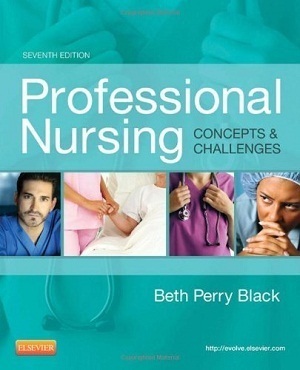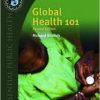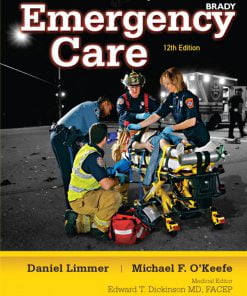Test Bank Professional Nursing Concepts Challenges 7th Edition Black
$35.00 Original price was: $35.00.$26.50Current price is: $26.50.
Test Bank Professional Nursing Concepts Challenges 7th Edition Black
Instant download Test Bank Professional Nursing Concepts Challenges 7th Edition Black pdf docx epub after payment.

Product details:
- ISBN-10 : 1455702706
- ISBN-13 : 978-1455702701
- Author: Beth Black
Now in full-color, this best-selling, easy-to-read text introduces you to the issues and trends you’re likely to encounter in any nursing practice setting. Each stand-alone chapter explores a specific topic and gives insightful discussions of issues such as the health care delivery system, professionalization in nursing, standards and scope of practice, socialization and nursing theories surrounding the profession, and political action facing nurses.
Table Of Contents:
- Interactive Review – Professional Nursing
- CHAPTER 1 Nursing today: A time of transformation
- Learning outcomes
- Status of nursing in the United States
- Numbers
- Gender
- FIG 1-1 Distribution of women and men in the overall RN population. The great disparity between the percentage of women and men in nursing is clearly evident.
- Age
- Race and ethnicity
- Education
- FIG 1-2 RN and the U.S. populations by race/ethnicity, 2008. The proportion of nurses who are white, non-Hispanic is greater than their proportion in the U.S. population.
- FIG 1-3 Initial nursing education of RNs working in nursing, 2008. ADN education accounts for almost half of RNs’ basic nursing education, although 55.6% of nurses report having a bachelor’s or higher degree as their highest education. NSSRN, National Sample Survey of Registered Nurses.
- Employment opportunities for nurses
- FIG 1-4 Although most nurses work in hospitals, nurses in home health settings often enjoy long-term relationships with their patients.
- Hospital-based nursing
- EVIDENCE-BASED PRACTICE NOTE
- FIG 1-5 Hospital staff nurses work closely with the families of patients, as well as with the patients themselves.
- Community health nursing
- Nurse entrepreneurs
- BOX 1-1 KAY WAGONER, PhD, RN
- Kay Wagoner, PhD, RN (Cardiovascular Nurse Specialist).
- Office-based nursing
- Occupational and environmental health nursing
- Military nursing
- School nursing
- FIG 1-6 School nurses manage a variety of students’ health problems, from playground injuries to chronic illnesses such as asthma and diabetes.
- Hospice and palliative care nursing
- Telehealth nursing
- Faith community nursing
- INTERVIEW
- Nursing informatics
- Nursing opportunities requiring advanced degrees
- Nurse educators
- Advanced practice nursing
- FIG 1-7 Advance practice nurses by specialty area, 2008. Although most nurse practitioners work in single roles, some work in dual advanced practice roles.
- Nurse practitioner
- Clinical nurse specialist
- BOX 1-2 SEBASTIAN WHITE, MSN, FNP, BC-ADM, RN
- Sebastian White, MSN, FNP, BC-ADM, RN.
- Certified nurse-midwife
- Certified registered nurse anesthetist
- Clinical nurse leader
- Issues in advanced practice nursing
- Employment outlook in nursing
- Key points
- Critical thinking questions
- Activities
- References
- CHAPTER 2 The history and social context of nursing
- Learning outcomes
- Historical context of nursing
- Mid–nineteenth-century nursing in england: The influence of florence nightingale
- FIG 2-1 Florence Nightingale (1820–1910), founder of modern nursing.
- 1861–1873: The american civil war: An impetus for training for nursing
- After the civil war: Moving toward education and licensure under the challenges of segregation
- The first training schools for nurses and the feminization of nursing
- FIG 2-2 Nurses training in the bacteriologic laboratory at Bellevue Hospital, New York City, circa 1900.
- FIG 2-3 Mary Eliza Mahoney (1845–1926), the first trained African-American nurse in the United States.
- Historical Note 2-1
- Professionalization through organization
- Nursing’s focus on social justice: The henry street settlement
- FIG 2-4 Lillian Wald (1867–1940), nurse and social activist. Wald founded the Henry Street Settlement, which is still in operation today, and was one of the founders of the National Association for the Advancement of Colored People (NAACP).
- FIG 2-5 Little deterred the Henry Street Settlement nurses from making their daily rounds on their patients in New York’s Lower East Side.
- Historical Note 2-2
- A common cause but still segregated
- FIG 2-6 Jessie Sleet Scales, a visionary African-American nurse, was among the first to bring community health nursing principles to the slums of New York City around 1900.
- War again creates the need for nurses: Spanish-american war
- Professionalization and standardization of nursing through licensure
- FIG 2-7 Red Cross nursing in the Spanish-American War, circa 1898. Nurses on deck of the hospital ship Relief near Cuba.
- FIG 2-8 A World War I Red Cross nursing poster, 1918. “Not one shall be left behind!” by James Montgomery Flagg is typical of World War I recruitment posters. Nurses answered the call in record numbers.
- 1917–1930: The challenges of the flu epidemic, world war I, and the early depression era
- FIG 2-9 Mary Breckinridge, founder of the FNS, on her way to visit patients in rural Kentucky.
- Historical Note 2-3
- 1931–1945: Challenges of the great depression and world war II
- World war II: Challenges and opportunities for nursing
- Historical Note 2-4
- 1945–1960: The rise of hospitals: Bureaucracy, science, and shortages
- 1961–1982: The great society, vietnam, and the change in roles for women
- FIG 2-10 The Vietnam War Women’s Memorial, dedicated in 1993, was established to honor women who served in Vietnam, most of whom were nurses.
- 1983–2000: Challenges for nursing: HIV/AIDS and life support technologies
- 2001–2015: The post–9/11 era, natural disasters, and health care reform
- Social context of nursing
- CRITICAL THINKING CHALLENGE 2-1
- Gender
- FIG 2-11 Despite their small numbers, men in nursing play an important role in the profession.
- BOX 2-1 FROM FLIGHT MEDIC TO FLIGHT NURSE: ONE MAN’S STORY
- Christopher McGrath, RN.
- Image of nursing
- The woodhull study on nursing and the media
- The johnson & johnson campaign
- FIG 2-12 An example of an advertisement that depicts men in nursing in a favorable way.
- BOX 2-2 THE WOODHULL STUDY AT A GLANCE
- Purpose of the study
- Key study findings
- Key study recommendations
- The truth about nursing
- FIG 2-13 Population projections, ages 65 to 84 years and ages 85 years and over: 2000–2050.
- National population trends
- Aging of america
- BOX 2-3 CHECKLIST FOR MONITORING MEDIA IMAGES OF NURSES AND NURSING
- Prominence in the plot
- Demographics
- Personality traits
- Primary values
- Sex objects
- Role of the nurse
- Career orientation
- Professional competence
- Education
- Administration
- Diversity
- Diversity in the profession
- Technologic developments
- FIG 2-14 Advanced technology is used to enhance clinical decision making in novices. Here students use a human simulator in a laboratory setting to refine their skills.
- FIG 2-15 National supply and demand projections for full-time equivalent (FTE) RNs, 2000–2020. In 2000 the national supply of FTE RNs was estimated at 1.89 million, whereas the demand was estimated at 2 million, a shortage of 110,000, or 6%. Based on what is known about trends in the supply of RNs and the anticipated demand, the shortage is expected to grow relatively slowly until 2010, by which time it will have reached 12%. At that point, demand will begin to exceed supply at an accelerated rate, and by 2015 the shortage will have almost quadrupled to 20%. If not addressed, and if current trends continue, the shortage is projected to grow to 29% by 2020. Factors driving the growth in demand include an 18% increase in population, a larger proportion of elderly persons, and medical advances that heighten the need for nurses.
- Initiatives to provide a stable supply of registered nurses
- Summary of key points
- Critical thinking questions
- Activities
- References
- CHAPTER 3 Nursing’s pathway to professionalism
- Learning outcomes
- Characteristics of a profession
- FIG 3-1 According to experts, professionals are motivated by altruism, a desire to help others.
- From occupation to profession
- Professional preparation
- Professional commitment
- Interprofessionality
- TABLE 3-1 COMPARISON OF CHARACTERISTICS OF OCCUPATIONS AND PROFESSIONS
- Nursing’s pathway to professionalism
- Kelly’s criteria
- “The services provided are vital to humanity and the welfare of society.”
- “There is a special body of knowledge that is continually enlarged through research.”
- “The services involve intellectual activities; individual responsibility (accountability) is a strong feature.”
- “Practitioners are educated in institutions of higher learning.”
- “Practitioners are relatively independent and control their own policies and activities (autonomy).”
- “Practitioners are motivated by service (altruism) and consider their work an important component of their lives.”
- “There is a code of ethics to guide the decisions and conduct of practitioners.”
- FIG 3-2 The Wheel of Professionalism in nursing.
- BOX 3-1 THE FLORENCE NIGHTINGALE PLEDGE
- “There is an organization (association) that encourages and supports high standards of practice.”
- Miller’s wheel of professionalism in nursing
- Standards established by the profession itself
- Nursing’s social policy statement: The essence of the profession
- A contract with society
- Nursing: Scope and standards of practice
- The code of ethics for nurses
- BOX 3-2 SELF-ASSESSMENT: AM I A PATIENT-CENTERED NURSE?
- Collegiality as an attribute of the professional nurse
- Barriers to professionalism in nursing
- Varying levels of education for entry into practice
- BOX 3-3 POINTS ON PROFESSIONALISM
- Gender issues
- Historical influences
- BOX 3-4 REPAVING THE PATH TO PROFESSIONALISM IN NURSING EDUCATION
- Isabel Hampton Robb.
- External conflicts
- Internal conflicts
- Nursing image and professionalism: Are these related?
- CRITICAL THINKING CHALLENGE 3-1
- Final comments
- CRITICAL THINKING CHALLENGE 3-2
- Summary of key points
- Critical thinking questions
- Activities
- References
People also search:
Professional Nursing Concepts Challenges 7th Edition
Professional Nursing Concepts Challenges 7th Edition pdf
Professional Nursing Concepts Challenges
what are the challenges in nursing
|
what are the challenges in nursing profession
|
Related products
Test Bank
Test Bank for Operating Systems: Internals and Design Principles, 7th Edition: William Stallings











